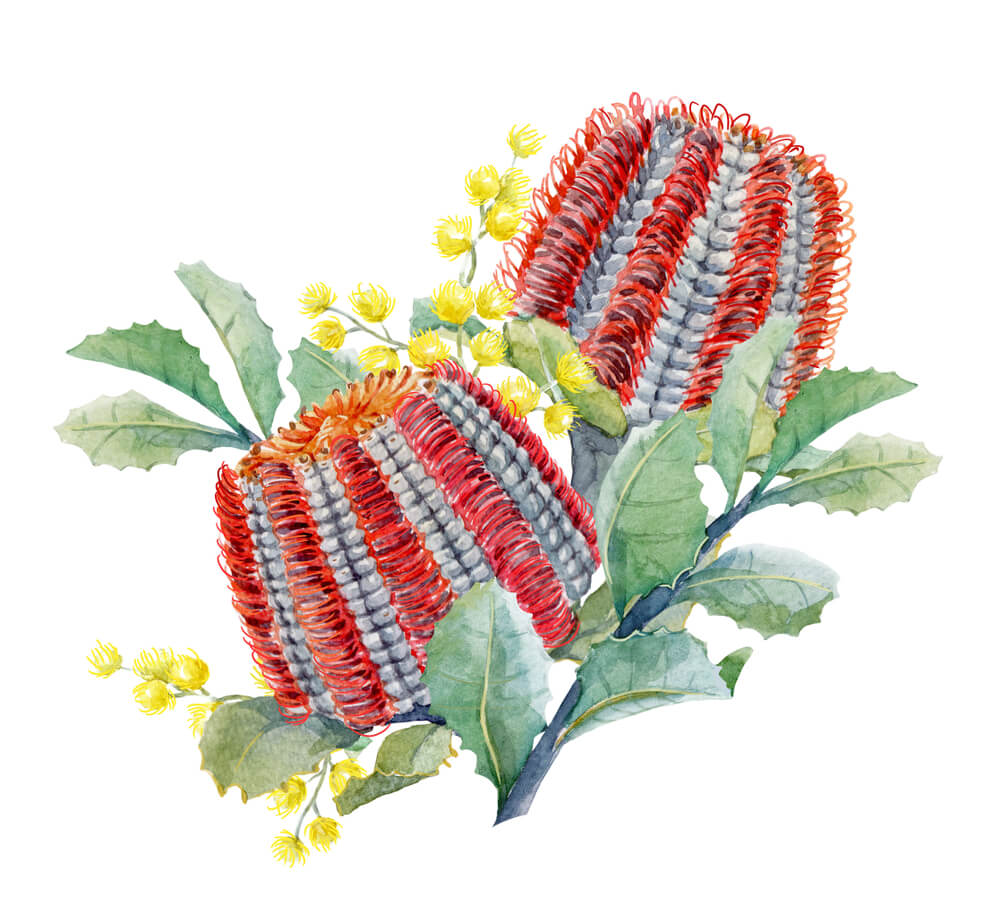How to Get Started in Australian Botanical Art

The art of documenting plants and flowers is having a resurgence, and more and more Australians, especially young Australians, are drawing what they see rather than taking photos. This is what’s referred to as “botanical art” or “botanic illustration”.
Botanical art and illustration involves documenting plant life, not only for art, but for science and environmental research. A botanical artist records the whole life cycle of the plant, evoking an ongoing cycle of growth, reproduction, decay and renewal. In one composition botanical art can have the buds, dying flowers, right through to the fruit and seeds. This is something that can’t be done with a camera, which only captures a moment in time.
Often meticulously observed, botanical artists can undertake months of research before putting paintbrush to paper. Many go as far as to add the pollinators like bees, ants or birds too.
The difference between botanical art and flower painting
The difference between a botanical artist and a flower painting is intention. A botanical artist considers the science and accuracy of their work, while a flower painter considers what will be most visually pleasing.
Botanical illustration is made from live plants of herbarium specimens to illustrate a botanical text (e.g. an article or monograph). Typically the illustration will depict ALL relevant aspects of the plant to enable accurate identification. More often than not, botanic illustrations are monochrome (drawn in pen and ink or digitally) to permit publication without the expense of colour reproduction.
With botanical art, the artwork is always scientifically and botanically correct but not necessarily complete. More emphasis is placed on the aesthetic value of the plant or flower and not ALL information is required. Botanical art may form part of a project and contribute to records and is generally in colour.
In flower painting, the emphasis is less about botanical accuracy and more about a pleasing painting. Flowers are often found in vases sitting within a still life context, or in a garden or the countryside. The style of the painting can also be more impressionistic and colours and size may not be accurate.
How to be a botanical artist
While botanical artists follow certain requirements in order to create accurate images so that plants can be identified, each botanical artist and illustrator follows a slightly different process. As with any art form, it’s important you find a process that works for you.
As mentioned above, many botanical artists can take months of research before putting paint brush to paper. This is because not only do you have to locate the plant in which you want to draw, you may have to revisit it and different times of the year to collect the flowers or its seeds. This doesn’t mean you can’t draw while you wait - take a sketchbook with you and take note of the essential features of the plant, measuring it carefully and noting its habit. Does it trail downwards or along the ground? What is the leaf shape? Does it climb? What are the colours?
Having got all the information down you need the next step is to determine which elements should be included in the illustration. This part may be directed by the commissioning botanist or you can use tracing paper to organise the plant to fit your sheet of paper in a pleasing way.
From here, paint in watercolour, building up layers of colour in a few washes followed by detail. Alternatively you could ink over your pencil drawings using rotring pens.
Five tips to remember when getting started:
- Draw only what you can see and not what you think you can see
- Don’t rush - it’s important that you do justice to the subject material and that might mean waiting until you have all the information
- Don’t be scared of mistakes - you’ve got to do a lot of drawing and look at a lot of different structures to really get to know a plant
- Take photos of live plants and then ink them from the photograph
- Take some time to understand the science behind the specimen you’re working with
Tools to get started
When you’re just starting out on a new painting/drawing adventure, knowing which art supplies you’ll need can be a challenge. Generally speaking, these are some of the tools you’ll need to get started with botanical art…
Sketchbook: Having somewhere to store your research is crucial. Look for a sketchbook with high-quality heavyweight paper for drawing and sketching and a hard cover for sturdiness when travelling.
Drawing materials: A graphite pencil set is a must for sketching out your research. Choose pencils made from quality graphite and clays and a barrel that allows for strength, covering power and control. A thicker pencil will make covering fairly large areas easy work.
Pencil sharpener: Pencils work best when sharpened appropriately and a good quality pencil sharpener that fits even the thickest pencil is what you want.
Paper: Paper can deteriorate and change colour over time and how fast this happens depends on the nature and the quality of the paper. In general, 100% cotton paper is considered the best for botanical art and paper with calcium carbonate can provide a buffer against discolouration. Watercolour paper is the next best thing.
Brushes: A brush is an extension of your own hand therefore it’s personal and sensitive. That said, if you are working with details and fine linear strokes and building up intense colour, sable brushes will give you better and cleaner results than synthetic brushes.
Paint: Some basic colours will serve you well in the beginning and you can build up your collection from there. Start with transparent or semi-transparent colours (no cadmium or white) in blue, yellow, red and burnt sienna.
Pick up all the tools you need at Discount Art N Craft Warehouse.
Where to look for inspiration
Want to get a feel for painting botanicals before you embark on months of research for accuracy? Turn to the experts for inspiration and check out artists like:
